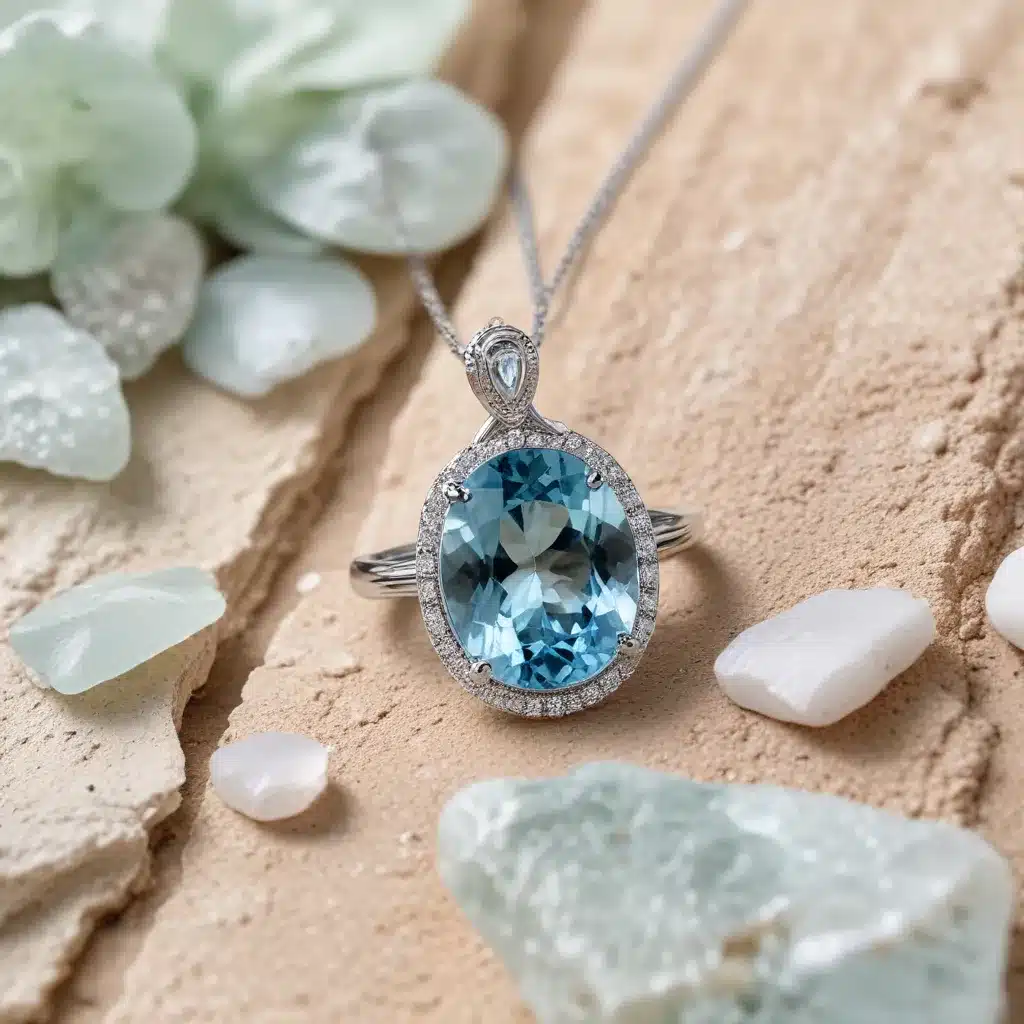
Aquamarine, the captivating birthstone of March, is a shimmering gem that exudes the tranquil essence of the sea. Tracing its origins to the Latin “aqua marina,” meaning “water of the sea,” this stunning blue-green variety of the beryl mineral family has long been revered for its soothing beauty and enchanting connection to the ocean.
Aquamarine Characteristics
Aquamarine is prized for its remarkable optical properties and enchanting range of blue hues. With a Mohs hardness of 7.5-8, it is a durable gemstone suitable for a variety of jewelry designs. The color of aquamarine can vary from pale blue-green to deep, vivid blue, a result of the stone’s chemical composition and the inclusions present in the crystal structure.
The most valuable aquamarines are those with a rich, saturated blue color, often achieved through careful heat treatment. This process permanently enhances the gem’s tone and clarity, making the vibrant blue hue a hallmark of the finest aquamarine specimens. Even the palest aquamarines, however, possess a tranquil beauty that evokes the calming essence of the sea.
Aquamarine Symbolism
Beyond its visual allure, aquamarine has long been associated with deep spiritual and emotional significance. In ancient times, sailors believed that carrying aquamarine on their voyages would ensure safe passage across the tumultuous waves. They would often toss the gems into the ocean as offerings to Poseidon, the mighty god of the sea, hoping to secure his protection.
The soothing blue hues of aquamarine have also been linked to inner peace, clarity, and open communication. This gem was once thought to have the power to enhance articulation and foster honest, forthright exchanges, making it a symbol of understanding and connection. In medieval Europe, aquamarine was even exchanged as a token of rekindled marital affection, believed to promote harmony and lasting love.
Aquamarine Formation
Aquamarine’s geological origins can be traced to the beryl deposits found in various mountainous regions around the world. The gem forms deep within the earth’s crust, where hydrothermal fluids rich in beryllium and aluminum slowly crystallize over time. The unique blue-green coloration of aquamarine is a result of the presence of iron impurities within the crystal structure.
Some of the most renowned aquamarine deposits can be found in Brazil, Pakistan, Nigeria, and Russia, where miners carefully extract the precious stones from pegmatite veins and alluvial sources. The largest and most flawless aquamarines are often unearthed in Brazil, where the gems are celebrated for their exceptional clarity and vibrant hues.
Aquamarine Varieties
In addition to the coveted natural aquamarine, the gemstone market also offers synthetic and treated varieties. Synthetic aquamarine, created in specialized laboratories, can replicate the natural stone’s optical properties and color with impressive accuracy. These lab-grown alternatives are often more affordable and consistent in quality compared to their natural counterparts.
Treated aquamarines, on the other hand, undergo various processes to enhance their appearance. Heat treatment, for instance, is a common practice that can improve the gem’s clarity and intensify its blue coloration. While treated aquamarines may be more economical, it is essential to disclose any enhancements to ensure transparency in the jewelry trade.
Aquamarine Jewelry
The serene beauty of aquamarine has long inspired jewelry designers and artisans to create breathtaking pieces that capture the essence of the sea. From classic solitaire rings to intricate necklaces and earrings, aquamarine is a versatile gemstone that lends itself well to a variety of settings and styles.
Contemporary designers have also embraced aquamarine’s timeless appeal, crafting bold, modern interpretations that showcase the gem’s captivating color and clarity. These innovative designs often incorporate unique cuts, such as the emerald cut or the cushion cut, to accentuate the gem’s natural brilliance.
Proper care and maintenance are crucial for preserving the beauty of aquamarine jewelry. The gemstone’s relatively high Mohs hardness makes it suitable for everyday wear, but it is still susceptible to scratches and chips. Owners should avoid exposing aquamarine to harsh chemicals or extreme temperatures, and periodic professional cleaning is recommended to keep the gem sparkling.
Aquamarine in Art and Literature
The enchanting allure of aquamarine has long captured the imagination of artists and writers throughout history. In the realm of fine art, the gem’s serene blue hues have been immortalized in the work of renowned painters, including the French Impressionist Claude Monet, whose iconic water lily paintings often feature the tranquil tones of aquamarine.
The literary world has also embraced the symbolic significance of aquamarine, with the gem appearing in the works of celebrated authors such as J.R.R. Tolkien, who described the “sea-blue stones” of Númenor in his “Lord of the Rings” series. Aquamarine’s association with the ocean, communication, and emotional harmony has inspired countless poets and storytellers to weave its captivating essence into their creative narratives.
Aquamarine Collectors and Connoisseurs
Aquamarine has long been coveted by gem enthusiasts and collectors worldwide, with some of the rarest and most valuable specimens finding their way into prestigious private collections and museum exhibitions. The Smithsonian Institution in Washington, D.C., for instance, is home to the “Dom Pedro,” a magnificent 10,363-carat aquamarine carved into the shape of an obelisk, one of the largest cut aquamarines in the world.
As awareness and appreciation for aquamarine continue to grow, the gemstone has also become an increasingly popular investment opportunity for savvy collectors. The most flawless and deeply hued aquamarines can command high prices at auction, making them a worthy addition to any portfolio of rare and valuable gems.
Whether admired for its serene beauty, cherished for its symbolic significance, or sought after by discerning collectors, aquamarine remains a captivating gem that evokes the timeless allure of the sea. As the birthstone of March, this enchanting blue-green gemstone serves as a reminder of the power of nature’s cycles and the tranquility that can be found in the vast, calming expanse of the ocean.

